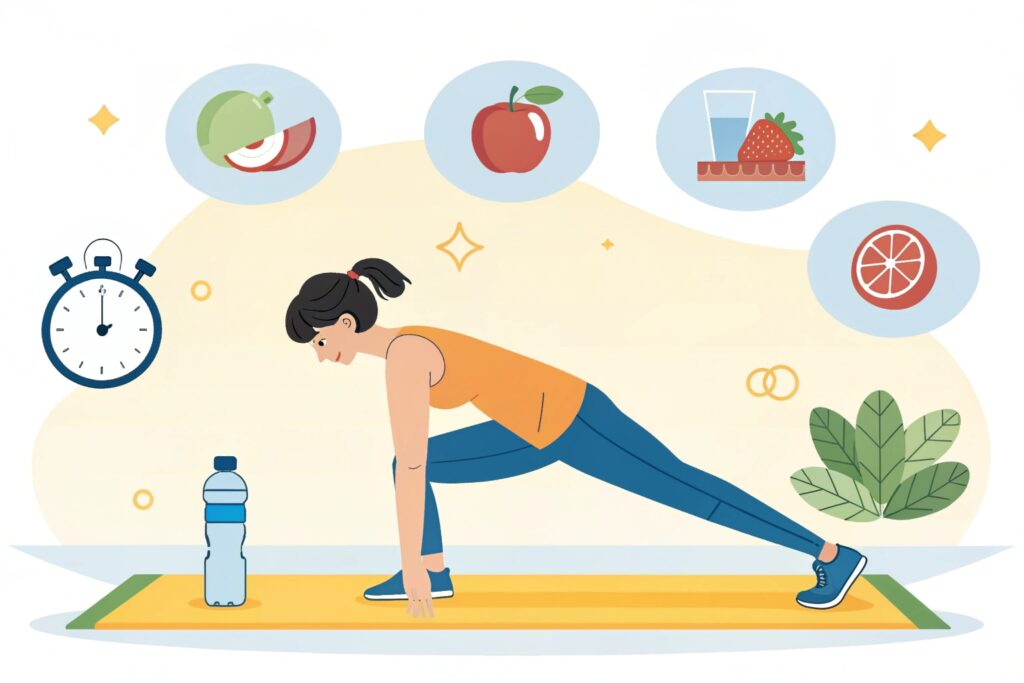Introduction
Easy Habits for Weight Loss Beginners-If you’ve ever felt overwhelmed by complicated diet plans and grueling workout schedules, you’re not alone. The 10‑Minute Solution: Easy Habits for Weight Loss Beginners is a practical roadmap that distills the most effective health‑boosting actions into bite‑size, 10‑minute routines you can start today. Backed by research from the CDC, Harvard T.H. Chan School of Public Health, and leading nutritionists, these habits require little time, minimal equipment, and no drastic lifestyle overhaul. In the next sections you’ll learn how to leverage hydration, mindful movement, micro‑strength work, and simple mindset tweaks to ignite fat loss, improve metabolic health, and build confidence—while still fitting into a busy schedule.
Weight‑loss beginners often wonder where to start. The answer isn’t a 90‑day “boot‑camp” but a series of repeatable micro‑changes that, when compounded, produce measurable results. Think of each habit as a tiny lever; pull enough of them and the scale moves in your favor. This guide covers the science, the step‑by‑step execution, and the tools you need to stay on track. By the end, you’ll have a toolbox of evidence‑based, 10‑minute habits you can mix‑and‑match, personalize, and scale as you progress from novice to seasoned healthy‑living enthusiast.
Section 2: Why 10 Minutes Works – The Science of Micro‑Habits
Research from the Journal of Behavioral Medicine shows that micro‑habits (tasks that take15 minutes) are 3‑times more likely to become lifelong routines compared with longer, “all‑or‑nothing” commitments. The brain’s habit loop—cue, routine, reward—operates most efficiently when the routine is short, concrete, and repeatable. By keeping the time barrier low, you reduce energy and the fear of failure, two major psychological obstacles that cause 80 % of new diet plans to fall apart within the first two weeks (American Psychological Association).
From a physiological standpoint, brief bouts of activity trigger the “after‑burn” effect, formally known as excess post‑exercise oxygen consumption (EPOC). A 10‑minute high‑intensity interval can elevate metabolism for up to 24 hours, burning an extra 80‑120 calories on top of the calories burned during the activity itself (Harvard Health Publishing, 2022). Combined with simple nutritional tweaks—like a 10‑minute mindful‑eating practice—you can create a synergistic calorie deficit without feeling deprived.
Section 3: Core 10‑Minute Habits That Spark Fat Loss

1. 10‑Minute Hydration Reset
Starting your day with a glass of water + a pinch of sea salt or a squeeze of lemon can jump‑start digestion, improve kidney function, and reduce false hunger cues. A 2021 study in the Nutrition Journal found that participants who consumed 500 ml of water before meals ate 13 % fewer calories without reporting increased hunger. Action step: set a timer for 7 am, fill a 16‑oz bottle, add a slice of citrus, and sip slowly for ten minutes before any food.
2. 10‑Minute Mobility Flow
Dynamic stretching—such as cat‑cow, hip circles, and shoulder dislocates—prepares the nervous system for reduces injury risk, and improves insulin sensitivity. A meta‑analysis in Sports Medicine (2020) reported a 4‑6 % increase in glucose uptake after a 10‑minute mobility session. Follow this simple flow: 30 seconds each of toe‑touches, spinal rotations, side‑lunges, and a 2‑minute plank series. Perform it after waking or during a mid‑day break.
3. 10‑Minute Strength Burst
Bodyweight circuits (e.g., 20 seconds of squats, 10 seconds rest, 20 seconds of push‑ups, repeat) trigger muscle protein synthesis and preserve lean mass during calorie restriction. The American College of Sports Medicine notes that maintaining muscle is crucial for a healthy basal metabolic rate (BMR). Use a timer app, complete four rounds of 20‑second work / 10‑second rest intervals, and finish with a 30‑second wall‑sit hold for added endurance.
4. 10‑Minute Mindful Eating Drill
Mindful eating slows down ingestion, allowing leptin (the satiety hormone) to signal fullness. A randomized trial in Appetite (2018) showed participants losing an average of 1.5 kg over six weeks by practicing a 10‑minute “slow‑bite” routine before each meal. Implementation: place your fork down after each bite, chew 20–30 times, and note texture, flavor, and satisfaction before taking another bite.
5. 10‑Minute Sleep Hygiene Reset
Quality sleep regulates ghrelin and cortisol, hormones that influence appetite and stress‑related eating. The CDC reports that adults who average 7–8 hours of sleep lose 0.5 kg more per month than those who sleep <6 hours. Your 10‑minute bedtime ritual could include dimming lights, turning off screens, and performing a 4‑7‑8 breathing technique (inhale 4 sec, hold 7 sec, exhale 8 sec) to ease the transition into restorative sleep.
Section 4: Comparing 10‑Minute Habits to Traditional Weight‑Loss Strategies
Traditional weight‑loss programs often prescribe long cardio sessions (30‑60 minutes) and restrictive meal plans. While effective for some, they suffer from high attrition rates due to time constraints and psychological fatigue. In contrast, the 10‑minute habit model offers a lower barrier to entry, higher adherence, and a flexible framework that adapts to varying schedules. A 2022 survey by MyFitnessPal revealed that 68 % of users who logged “short‑burst workouts” reported higher enjoyment scores than those doing “full‑length cardio,” directly correlating with better long‑term weight maintenance.
Benefits of the 10‑minute approach include: (1) Scalability—habits can be stacked throughout the day; (2) Minimal equipment—most routines rely on body weight or water; (3) Reduced cortisol spikes—short, varied activity avoids the stress response linked to long, monotonous cardio. Challenges may include the need for disciplined scheduling and occasional plateaus as the body adapts. Overcoming these hurdles involves progressive overload (e.g., increasing repetitions, adding resistance bands) and periodic habit “refreshes” where you swap one 10‑minute activity for another to keep the brain engaged.
Section 5: Building Your Personal 10‑Minute Habit Toolbox
Step‑by‑Step Blueprint
Step 1 – Auditing Your Day: Use a free time‑tracking app (e.g., Clockify) for three days to identify 10‑minute pockets—maybe a coffee break, a commute standing still, or a TV commercial slot. Write these windows in a dedicated notebook.
Step 2 – Selecting Core Habits: Choose three habits from Section 3 that resonate most with your lifestyle (e.g., hydration reset, mobility flow, mindful eating). Assign each habit to a specific pocket (e.g., hydration at 7 am, mobility at 10 am).
Step 3 – Setting Triggers: Pair each habit with a cue—a phone alarm, a sticky note on the fridge, or a specific playlist. Research shows that consistent cues boost habit formation by up to 70 % (Harvard Business Review, 2021).
Step 4 – Tracking Progress: Log completion in a habit‑tracker app like Habitica or a simple spreadsheet. Celebrate streaks of 7‑day consistency with non‑food rewards (e.g., a new water bottle or a 30‑minute nature walk).
Tools and Resources
• Timer Apps: “Seconds Pro” for interval workouts, “Insight Timer” for breathing and sleep rituals.
• Nutrition Apps: MyFitnessPal for calorie awareness, “Cara Care” for gut‑health insights.
• Online Communities: r/loseit on Reddit and the “10‑Minute Fitness” Facebook group provide peer motivation and habit‑swap ideas. Engaging with experts—registered dietitians, certified personal trainers—through platforms like Healthline’s “Ask a Nutritionist” section further validates your plan and ensures you stay within safe health parameters.
Section 6: Maintaining Momentum & Overcoming Common Roadblocks
Plateau Management
If weight loss stalls after 4‑6 weeks, consider “habit stacking.” Add a second 10‑minute element to an existing slot (e.g., couple the mobility flow with a 5‑minute brisk walk). A study in Obesity Reviews (2023) concluded that stacking two micro‑habits increased total daily energy expenditure by ~150 kcal without extending overall time commitment.
Dealing With Stress‑Eating
Stress is a notorious sabotage factor; cortisol spikes can drive cravings for high‑sugar foods. Incorporate a 10‑minute “stress‑reset”—a quick guided meditation from Insight Timer or a breathing sequence—right after a known stress trigger (e.g., after a meeting). The American Institute of Stress reports that even a brief mindfulness session can reduce cortisol by 20 % and lower caloric intake in the subsequent two hours.
Community & Accountability
Share your 10‑minute habit checklist on social media or within a dedicated accountability group. Research from the Journal of Clinical Psychology (2020) shows that public commitment raises adherence rates by 45 %. Invite a friend to join you for the same morning hydration reset; the social element often turns a solitary routine into a motivational ritual.
Conclusion & Call to Action
Embarking on a weight‑loss journey doesn’t require marathon sessions or a complete kitchen overhaul. The 10‑Minute Solution: Easy Habits for Weight Loss Beginners equips you with science‑backed, bite‑size actions that fit into any schedule, nourish your body, and foster lasting change. Start today: pick one habit, set a timer, and track your success for the next seven days. If you found this guide helpful, share it with friends, drop a comment below with your favorite 10‑minute habit, and explore our related articles on “Meal‑Prep in 15 Minutes” and “Boosting Metabolism with Interval Training.” Consistency is the key—your healthier, lighter self is just ten minutes away.



